Four St. Croix pros share tips on their favorite presentations and the specific Victory rods on which they rely
PARK FALLS, Wisc. — January 17, 2022 – Like most forms of angling, bass fishing is an ever-evolving puzzle. It’s also a personal one. Regardless of your experience level, there are always new things to learn that can help you earn more success. From tackle-centric things like knots, rods, lures, lines and sonar to fish-related subjects like biology, habitat, forage and seasonal movements, pick a category or topic and you’ll find plenty to dive into. Then try applying the things you’ve learned on the water. This is how each of us grow and become better anglers.
Stepping outside your comfort zone and learning a new technique, or refining one, is one of the best ways to improve your bass fishing success and satisfaction. Ready to start soaking it in? We asked four more of our St. Croix pros to share details on one of their favorite bass presentations.
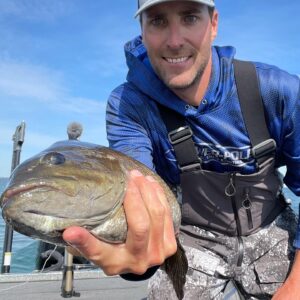 Hair Jigging with Travis Manson, Philadelphia, Pennsylvania
Hair Jigging with Travis Manson, Philadelphia, Pennsylvania
Smallmouth specialist and previous Bassmaster Elite angler, Travis Manson, is owner of Travis Manson’s Guide Service and host of the popular Smallmouth Crush live stream and podcast. The wayfaring guide grew up fishing in northern Wisconsin, but now tackles Maryland’s Chesapeake Bay, as well as upstate New York’s St. Lawrence River and Lake Ontario’s 1000 Islands region. He’s particularly handy with a jig, and as angler and guide who spends hundreds of days per year fishing for smallies, Mason considers hair jigs absolutely imperative. “It’s effective at catching smallmouth anywhere fish have good visibility. If I can see two to three feet or more into the water, I feel good about using the hair jig,” says Manson.
MANSON
The proclivity of hair jigs to entice big fish is now well-known, but that wasn’t always the case. “There is something about the hair jig that smallmouth love, and for a number of years a lot of high-profile anglers were able to keep it to themselves,” Manson says. “Although the hair jig has been around for a long time it really started to come back in the smallmouth community in the mid 2000’s. There were a few years when only a few anglers were consistently using this bait and doing very well before word got out. It can be a magical technique at times.”
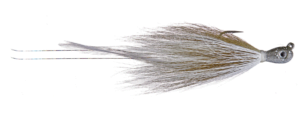 Manson says he’s always got a hair jig tied on and ready to go, regardless of the season. “Early spring when the water temps are still in the 30’s and 40’s, hair jigging can be one of the only techniques that will actually work, and success continues as the water warms, too,” Manson notes. “Throughout the summer months a lot of our Great Lakes smallmouth love to feed shallow. Fishing the hair jig in two-to-ten feet of water on flats and the top side of steep break lines is very effective.”
Manson says he’s always got a hair jig tied on and ready to go, regardless of the season. “Early spring when the water temps are still in the 30’s and 40’s, hair jigging can be one of the only techniques that will actually work, and success continues as the water warms, too,” Manson notes. “Throughout the summer months a lot of our Great Lakes smallmouth love to feed shallow. Fishing the hair jig in two-to-ten feet of water on flats and the top side of steep break lines is very effective.”
BUCKAROO JIG
Manson says casting with the wind to your back is the best way to fish a hair jig because it helps maximize casting distance. “Most of the jigs I use on a regular basis are 1/8-ounce or lighter. I want to make a long cast and make a slow horizontal swimming presentation,” he advises. “You want to pay attention to your bait on the retrieve and take notice if you see a bass following the jig. If you still have a lot of retrieve left, don’t stop the bait. That fish still might commit. If it doesn’t eat and isn’t spooked by your presence, throw the hair jig right back near the direction the fish is moving and let it fall to the bottom. A lot of times that fish will come over and eat the jig as it is lying motionless on the bottom. Try some small twitches if necessary. If the fish still doesn’t commit, try feeding it a follow-up bait like a Ned rig or drop shot.”
Manson delves into the details that are critical to successful hair jigging. “I won’t use anything larger than five-pound braid because it helps maximize casting distance,” he says. “I like white line because anytime I am fishing a bait horizontally through the water column I want the line to blend into the sky. Often times a fish is looking up at the bait and that white line blends really well in clear water. A leader is also a must. I prefer to use at least six feet of either six- or eight-pound fluorocarbon as a leader.”
Manson says the specialized work of hair jigging requires an equally specialized rod. “Any spinning rod over seven feet long with a medium-light power and a fast or extra-fast action will suffice,” he says, “but an even longer rod will help deliver longer casts and better hooksets, and an extra-fast tip aids in casting accuracy and bite detection.” With such specifications on the table, it should be no surprise that Manson’s favorite hair-jigging rod is St. Croix’s new 7’10” Victory Cross Hair Rod (VTS710MLXF).
“The Victory Cross Hair rod makes some of the longest casts possible and excels in everything I need a hair-jigging rod to do,” Mason says. “It’s light, sensitive, well-balanced and extremely comfortable to fish with. That said, you also need a smooth spinning reel designed for long casting light line. I tend to prefer 3000-size spinning reels because they typically have a wider spool which helps increase casting distance and line management. They usually also have a higher gear ratio, which can also be helpful.”
Max Cranking with Dennis Berhorst, Holts Summit, Missouri
Victory in bass fishing takes many forms, and many techniques don’t require the same tactile feel that certain finesse presentations like hair jigging require. Enter St. Croix staffer and crankbait guru, Dennis Berhorst. The Missouri-based MLF pro cut his teeth on throwing big cranks along deep ledges and hard breaks in big southern reservoirs and has refined his skills with the technique in competitive fishing across the US.
BERHORST
“Boy, do I like catching bass on a deep, or even medium running crankbait,” Berhorst says. “It’s a big topic, and there are a lot of ways to catch bass cranking and winding. I usually like to deep crank in late spring when fish are done spawning and move out to deeper water to feed up. An active crankbait presentation does a good job of mimicking those shad and other baitfish the bass are there for.”
Berhorst’s post-spawn reservoir cranking strategies are based, in part, on moving water. “I think current helps fish position for ambushing shad or whatever they are feeding on,” he says. “So, you’re looking for those smaller places along those ledges, creek channels, or other deep structure where they can sit out of the current and let the bait come past them,” he adds.
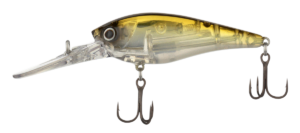 Berhorst starts his search in 10 feet of water or deeper. “Deep to me is 15 to 25 feet, and medium is 10 to 15 feet,” says Berhorst, noting that knowledge of different baits and their dive curves makes a big difference when taking on these post spawn fish. Of course, cranking is far from a spring or summer-only technique, as Berhorst also uses medium and deep crankbaits to target fish that move shallower as water temperatures cool in the fall.
Berhorst starts his search in 10 feet of water or deeper. “Deep to me is 15 to 25 feet, and medium is 10 to 15 feet,” says Berhorst, noting that knowledge of different baits and their dive curves makes a big difference when taking on these post spawn fish. Of course, cranking is far from a spring or summer-only technique, as Berhorst also uses medium and deep crankbaits to target fish that move shallower as water temperatures cool in the fall.
Berhorst encourages anglers to think of medium and deep crankbaits as both a searching and a catching technique. “A lot of anglers use deep cranks to catch one fish out of a school or pocket, then they change to another technique like dropshotting or a jig because they think they can be more precise or efficient with their presentations, or that they’ll have better results on neutral bass,” he says. “That’s sometimes the case, but a lot of times it isn’t necessary. Crankbaits just get that reaction bite and also do a great job at causing multiple bass to compete with one another. A good crankbait angler knows that and doesn’t pick up another rod until they’re sure those remaining bass aren’t going to eat.”
CRANKIN
Traditionally, deep-crankbait anglers have often had to compromise when it comes to rod selection. Sensitivity could be achieved to feel the bait at depth but casting distance and hooking percentage often suffered. Slower rods eventually became favored, but many with this correct action lack the feel necessary to understand the underwater world through contact with the structure. These kinds of compromises are less evident when fishing shallow-running crankbaits and are exaggerated when fishing deep-running baits. That’s what makes Berhorst’s favorite deep-cranking rod the new St. Croix Victory Max Cranker (VTC710XHM). “It’s just such a treat to fish,” he says. “It has the length and extra-heavy backbone to properly load the rod for long casting with big cranks and great sensitivity so you can feel what that bait is doing down there 20 feet deep. Plus that sweet, moderate, parabolic action that you need to keep bass connected to those trebles once they strike and are hooked,” says Berhorst. “Casting distance is what lets you get that bait down into the strike zone and keep it there as long as possible, then you’ve got excellent feel on the retrieve; it’s the secret sauce to having success with deep cranks,” Berhorst says. “This rod is also really versatile. Fish set up at certain depths, and the VTC710XHM does a great job of casting and retrieving just about any medium- or deep-diving crankbait model in my arsenal.”
Punching Part 2 with Joe Balog, Deland, Florida
Joe Balog is no stranger to technique-driven innovation. As a national tournament competitor and guide, he revolutionized new ways to target smallmouth on the Great Lakes throughout much of the 2000’s. These days, the St. Croix pro and fishing promoter wears many hats in the fishing biz but is still as passionate about big bass as ever – possibly even more so, now that he resides in central Florida. The self-described big-bass snob plies a variety of techniques to put giants in the boat, but like the rest of us, has his favorites.
 “Without question, punching is the premier method for catching a giant bass with artificial lures, especially in Florida,” says Balog. “It’s a technique that excels in water bodies with cover too thick to access the big bass hiding within by other techniques or presentations. These are the areas that attract the biggest bass in the lake due to the ability for the fish to get away from angling pressure, hunt large prey fish successfully, enjoy cooler temps and abundant oxygen, and take up residence in a home turf.”
“Without question, punching is the premier method for catching a giant bass with artificial lures, especially in Florida,” says Balog. “It’s a technique that excels in water bodies with cover too thick to access the big bass hiding within by other techniques or presentations. These are the areas that attract the biggest bass in the lake due to the ability for the fish to get away from angling pressure, hunt large prey fish successfully, enjoy cooler temps and abundant oxygen, and take up residence in a home turf.”
After giving up tournaments, Balog homed in on fishing exclusively for trophies, giving up on the developing patterns or bites for numbers and chasing only big fish. “For that reason, I’ve limited my techniques to just a handful, capable of routinely producing big fish. Of all these techniques, punching has proven to be the best for huge fish,” says Balog.
Joe relies on just one Victory series rod for the technique, the 7’11” Knockout (VTC711HMF), a rod he worked with St. Croix’s Product and Engineering Teams to test extensively.
BALOG TEST
He describes how it benefits his punching approach. “The most important aspects of this rod include the length and action. I prefer the longest rod available, because it picks up more line on a hookset, moves a fish away from heavy cover better, and gets the angler more vertical, over his or her lure when flipping,” says Balog. “A good punching rod should be powerful, but the action must be more parabolic than, say, a swim-jig rod, or a worm rod. It needs to flex in the midsection for one very important reason: to continue pressure during a sweeping, pull-set. When punching, it’s imperative to pull the hook into the fish, while moving it up and out of the cover all in one motion.”
For anglers new to punchin’, Balog describes it as “a viable technique year-round.” Best times are in early spring when most big fish are shallow, or when unseasonably cold winter weather pushes big bass up under mats. Yet, the technique is also great in summer and fall. Balog says, “Much of our fishing here in Florida revolves around the state of the grass, rather than the season. For instance, if left untreated, grass of all kinds will get incredibly thick by late summer, leading to awesome punching in places anglers can still access. But often times the grass is sprayed, taking away the potential for that technique. So the best time is, really, anytime there’s good, thick grass. Water type may vary, but punchin’ works in a variety of cover, from hydrilla, floating mats of hyacinth, dollar weed, and pennywort, to mud mats, tussock islands, flooded bushes and willows.”
Balog says the Victory Knockout excels here due to inherent sensitivity in the blank. “One of the biggest keys is feel. Most beginners to the technique have no idea how many fish are biting their baits. They discount the subtle taps and light bites.” SCIII+, a hybrid of St. Croix’s advanced SCIII carbon and exotic SCVI carbon, makes those subtle taps no longer indistinguishable from cover, bottom, or even panfish. Many times the bass just barley hold the bait, so feel is imperative. The Victory Series is very sensitive, despite the surprisingly low price point, and allows me to really feel what’s going on under the mat.”
The Wildcard with Andrew Ragas, Minocqua, Wisconsin
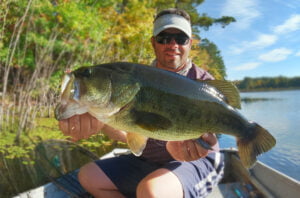 From Florida and Midwest bucketmouths to smallies of the north and beyond, it’s important to note the versatility of the Victory series. In-demand bass guide of Wisconsin’s Northwoods, Andrew Ragas, sums up that versatility in one rod, the Marshal (VTC73MHF). “I am enamored with the sensitivity and strength and amazed by the power and backbone of the Marshal. Not only is it tech-specific, but universal and multi-purpose as well; traits that I need for the typical guide trip in which numerous fishing scenarios play out over the course of a day,” says Ragas, who has access to hundreds of great smallmouth and largemouth waters in the Minocqua, Wisconsin area. While Ragas targets both species with individual technique-specific rods, sometimes it’s nice to have a jack-of-all-trades.
From Florida and Midwest bucketmouths to smallies of the north and beyond, it’s important to note the versatility of the Victory series. In-demand bass guide of Wisconsin’s Northwoods, Andrew Ragas, sums up that versatility in one rod, the Marshal (VTC73MHF). “I am enamored with the sensitivity and strength and amazed by the power and backbone of the Marshal. Not only is it tech-specific, but universal and multi-purpose as well; traits that I need for the typical guide trip in which numerous fishing scenarios play out over the course of a day,” says Ragas, who has access to hundreds of great smallmouth and largemouth waters in the Minocqua, Wisconsin area. While Ragas targets both species with individual technique-specific rods, sometimes it’s nice to have a jack-of-all-trades.
RAGAS
 “On the northern Wisconsin inland lakes I guide on, many of the best smallmouth fisheries are deep structure and open-water oriented,” Ragas notes. “So that leads to spending most days on the water off-shore. Casting and jigging are two of our daily strategies. Some days, both methods work, but most days, it’s one or the other.” Yet, for the baits Ragas is throwing, the Marshal serves dual duty here. “Year-round, the Marshal is outstanding for casting small paddletails and swimbaits such as the 3.8” Strike King Rage swimmer and Keitech Swing Impact Fat. It also handles bigger four-to-six-inch paddletails rigged with ½-ounce-to-¾-ounce heads and weights, no problem. The Marshall’s 7’3” length enables long casting, and its power delivers positive hook-sets from long distances.”
“On the northern Wisconsin inland lakes I guide on, many of the best smallmouth fisheries are deep structure and open-water oriented,” Ragas notes. “So that leads to spending most days on the water off-shore. Casting and jigging are two of our daily strategies. Some days, both methods work, but most days, it’s one or the other.” Yet, for the baits Ragas is throwing, the Marshal serves dual duty here. “Year-round, the Marshal is outstanding for casting small paddletails and swimbaits such as the 3.8” Strike King Rage swimmer and Keitech Swing Impact Fat. It also handles bigger four-to-six-inch paddletails rigged with ½-ounce-to-¾-ounce heads and weights, no problem. The Marshall’s 7’3” length enables long casting, and its power delivers positive hook-sets from long distances.”
In the deep-jigging part of the equation, Ragas notes, “it excels in cracking the tube and covering the depths with a football jig. Another cool strategy it does really well is speed-crawling the bottom with Tokyo rigs and swinging head jigs. These methods each get employed heavily during fall, so it’s nice to have a rod that rides in the boat during all times of the year.” Besides smallmouth, it’s a great rod choice too largemouth, too, where Ragas mentions it gets heavy usage by clients. “It has the necessary medium-heavy power and structural capacity for ripping and handling swim jigs through grass, punching a downsized creature bait, and the Carolina Rig worked deep,” says Ragas. “It’s amazing how much this single rod excels at.”
Big bronzebacks in clear water are notoriously spooky, which is why Ragas focuses on longer rods that offer better casting distance. “For my smallmouth casting strategies, my personal requirement is a longer length, with a medium-heavy power at minimum. Both are criteria for the long-distance bomb-casting and search fishing methods I do on my local waters. Anything lower and lesser, it’ll be more difficult in taming the beast,” says Ragas. “I can’t wait to also fish with the Marshal’s 2-inches longer brother, the Max Marshal (VTC75MHF), which should be even better for long-distance casting paddletails and Carolina rigging. The multi-purpose usability of the Marshal quickly found its role and place for me. It’s my Swiss Army knife in the Victory Rod Series.”
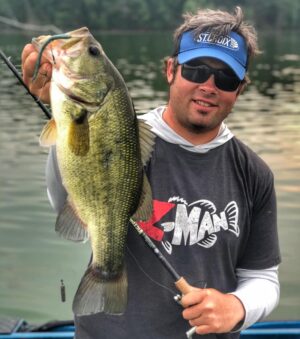 Fishing tips are always appreciated, but these are master-strokes by talented folks that all utilize purpose-driven technology in custom-engineered St. Croix Victory rod models to their advantage. No matter where or how you fish for bass, there’s a Victory made for that situation. All 25 fish-catching models are handcrafted in the USA with a 15-year warranty, and lucky for you, most come in at $200 or less. So go ahead and gear up for that next new technique – whatever it may be. Your new Victory rod was made for it.
Fishing tips are always appreciated, but these are master-strokes by talented folks that all utilize purpose-driven technology in custom-engineered St. Croix Victory rod models to their advantage. No matter where or how you fish for bass, there’s a Victory made for that situation. All 25 fish-catching models are handcrafted in the USA with a 15-year warranty, and lucky for you, most come in at $200 or less. So go ahead and gear up for that next new technique – whatever it may be. Your new Victory rod was made for it.
#CROIXGEAR
Like the rods? You’ll love our lifestyle apparel.
INSERT VICTORY APPAREL –#stcroixrods
About St. Croix Rod
Headquartered in Park Falls, Wisconsin, St. Croix has been proudly producing the “Best Rods on Earth” for nearly 75 years. Combining state-of-the-art manufacturing processes with skilled craftsmanship, St. Croix is the only major producer to still build rods entirely from design through manufacturing. The company remains family-owned and operates duplicate manufacturing facilities in Park Falls and Fresnillo, Mexico. With popular trademarked series such as Legend®, Legend Xtreme®, Avid®, Premier®, Imperial®, Triumph® and Mojo, St. Croix is revered by all types of anglers from around the world.

